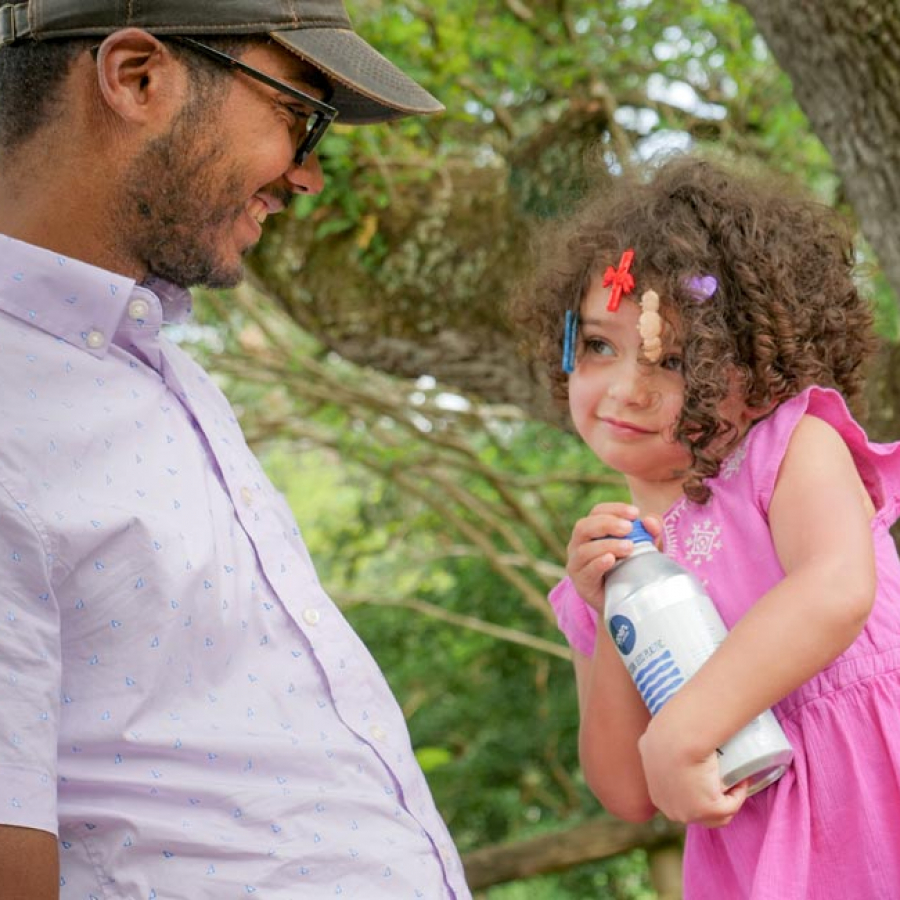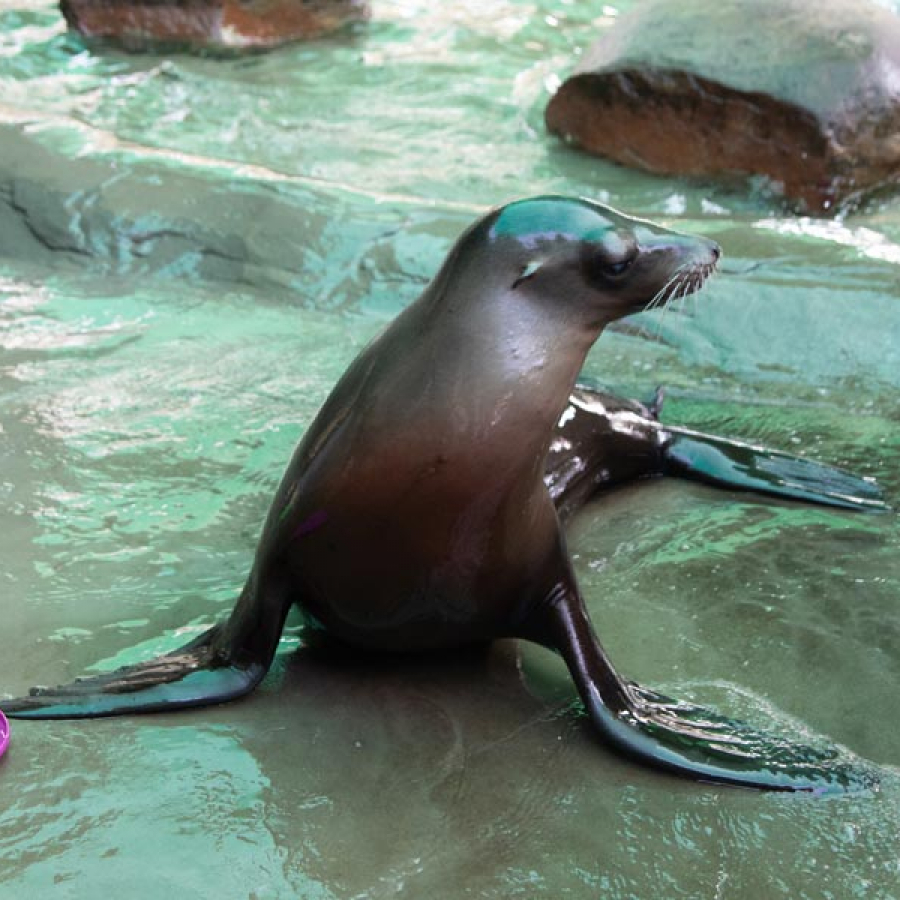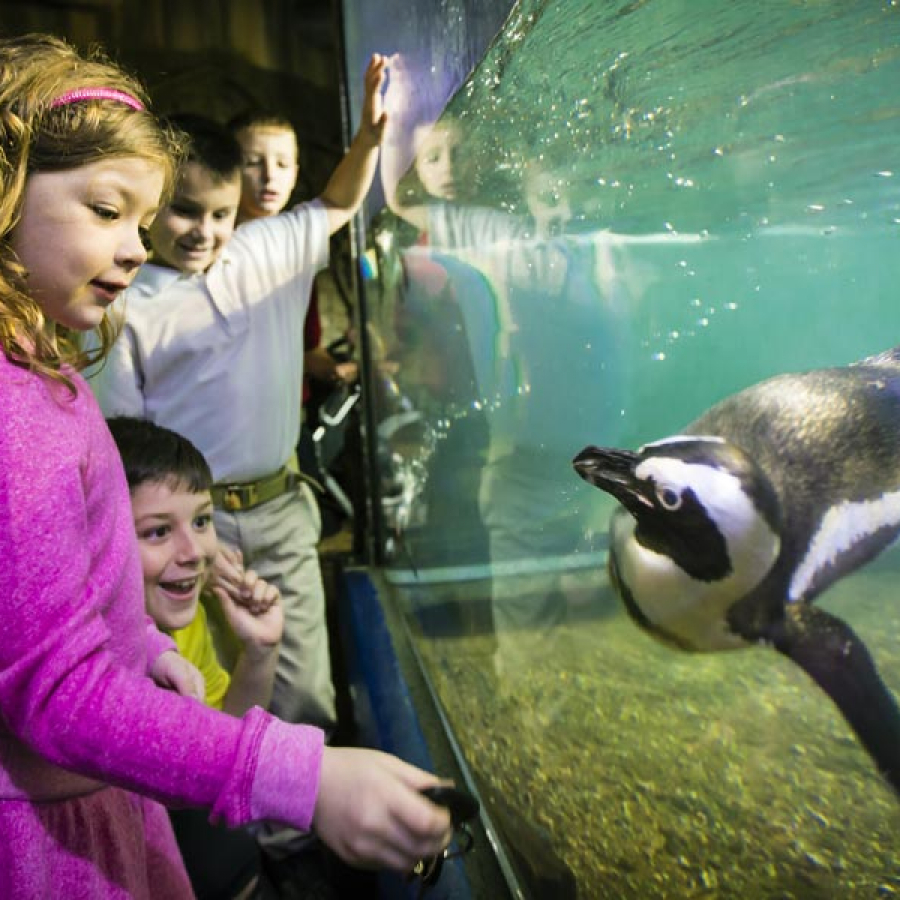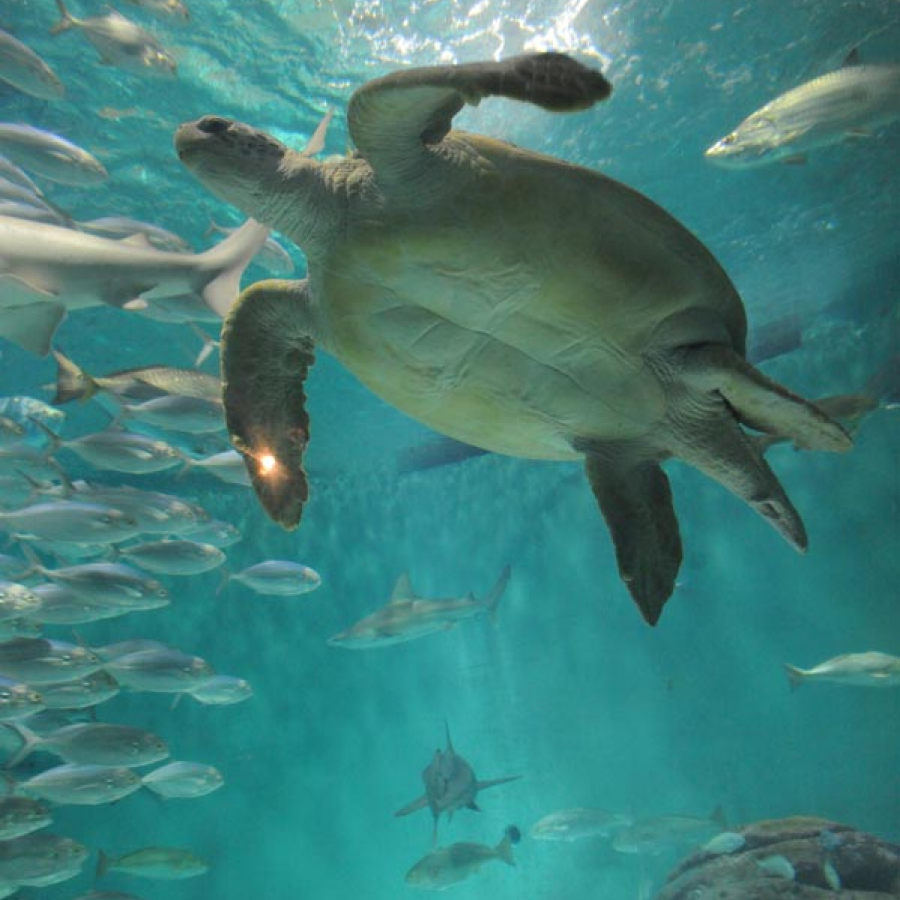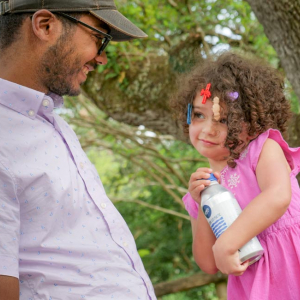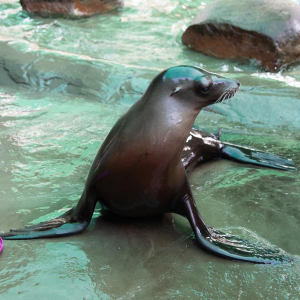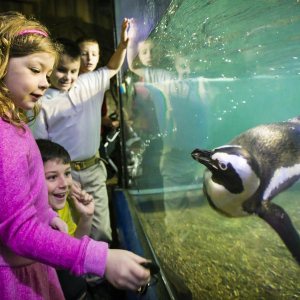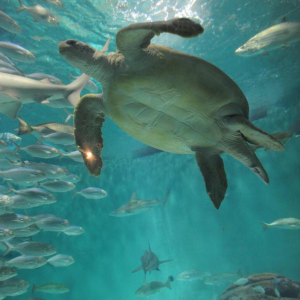Want to make a difference for marine life? Join the Plastic Free Ecochallenge as a member of the “Plastics Free NOLA” team and help us fight plastic pollution!
With recent changes to municipal recycling rules, now is the perfect time to take a look at your habits with single-use plastics and see where you can make some easy changes.
Plastic Free July is 31-day global challenge to reduce and refuse single-use plastics. Inspired by this movement, Ecochallenge.org and Columbus Zoo and Aquarium created a coalition of North American zoos and aquariums to bring this effort into their communities. As a sponsor of the campaign, Audubon Nature Institute is hosting the challenge for our region.
Approximately 8.8 million tons of plastic enters the ocean from land each year (one dump truck full of plastic per minute!), and plastic straws are among the most common types of litter picked up during beach cleanups. In fact, there’s so much marine debris in the ocean, there’s something called the “Great Pacific Garbage Patch,” which is a floating collection of marine debris in the North Pacific Ocean. Trash makes its way into the ocean through dumping and also through litter and trash on land being washed into waterways by rain. Then, current and weather patterns push debris together into two big piles, and since most of the debris is not biodegradable—like plastic—the garbage patch just grows and grows. Because of these current patterns, a plastic bottle thrown on the ground in a coastal California town can find its way across the Pacific to the coast of Japan! And that’s just what we can see. In addition to pieces of trash visible to the naked eyes, the garbage patch is also full of microplastics, which are only visible because they make the water under and around the patch cloudy. Below the surface, oceanographers and ecologists recently discovered that about 70 percent of marine debris actually sinks to the bottom of the ocean.
Eighty percent of plastic in the ocean is estimated to come from land-based sources, with the remaining 20 percent coming from boats and other marine sources. These percentages vary by region, however. The Gulf of Mexico contains some of the highest concentrations of microplastics in the world. This is likely the result of inland plastic pollution from the Mississippi River, which drains nearly 41 percent of the contiguous United States into the Gulf.
Plastic waste can have a significant impact on marine life in the wild, such as all the species you see at Audubon Aquarium of the Americas and the sea lions, otters, and many birds you see at Audubon Zoo who serve as ambassadors for their species. Animals can become entangled, leading to suffocation or drowning. When ingested, plastics can block digestive tracts, leading to starvation.
“Audubon is committed to leading our community by example when it comes to protecting the environment,” says Audubon Director of Sustainability and Coastal Conservation John Fallon. “Since 2017, we’ve gotten rid of plastics straws, eliminated plastic bags in our gift shops, and moved from plastic beverage bottles to aluminum cans or bottles—even for water.”
When you sign up for the Plastic Free July Ecochallenge, you’ll choose tangible actions like these to focus on throughout the month, such as skipping the straw or bringing reusable bags to the supermarket.
Through an easy-to-use online platform, you can track progress, share successes and challenges with others, and earn points for completed actions. You can also find lots of helpful suggestions on steps you can take and sustainable swaps for commonly used plastic items.
Even if you don’t participate in the challenge, there are simple changes you can make every day to reduce the amount of plastic waste you produce. Say no to plastic bags—these can’t be recycled through typical curbside recycling. And including these in your recycling bin contaminates the entire load, which usually means the load will end up in a landfill. This includes bagging your recycling in a plastic garbage bag or including items like plastic sandwich/storage bags, cling film, plastic food packaging, and bubble wrap. (If you do need to dispose of any plastic grocery bags though, some grocery stores have special collection bins just for that.)
Because these dissolve into microplastics that enter water streams and are ingested by wildlife—and humans—and are frequently contaminated with food, there is no practical way to dispose of or recycle these materials that doesn’t harm the environment or wildlife. The best approach is to use them as little as possible and keep them out of your recycling bin. There are lots of reusable alternatives, such as cloth grocery bags and silicone zippable storage bags or silicone bowl/plate covers.
You can also look for sustainable swaps for many of your everyday items—many of the “disposable” items we use in our everyday lives now have more sustainable/reusable alternatives available and they’re becoming more widely available every day. Basically, beware of anything “disposable” and check for reusable alternatives. Some common items to look for include:
To learn more about how to fight plastic pollution, visit AudubonNatureInstitute.org/Conservation-Programs/Plastic-Pollution. Join the fight today by signing up for the Plastic Free July Ecochallenge at PlasticFree.EcoChallenge.org and joining Audubon Nature Institute’s “Plastic Free NOLA” team.
With recent changes to municipal recycling rules, now is the perfect time to take a look at your habits with single-use plastics and see where you can make some easy changes.
Plastic Free July is 31-day global challenge to reduce and refuse single-use plastics. Inspired by this movement, Ecochallenge.org and Columbus Zoo and Aquarium created a coalition of North American zoos and aquariums to bring this effort into their communities. As a sponsor of the campaign, Audubon Nature Institute is hosting the challenge for our region.
Approximately 8.8 million tons of plastic enters the ocean from land each year (one dump truck full of plastic per minute!), and plastic straws are among the most common types of litter picked up during beach cleanups. In fact, there’s so much marine debris in the ocean, there’s something called the “Great Pacific Garbage Patch,” which is a floating collection of marine debris in the North Pacific Ocean. Trash makes its way into the ocean through dumping and also through litter and trash on land being washed into waterways by rain. Then, current and weather patterns push debris together into two big piles, and since most of the debris is not biodegradable—like plastic—the garbage patch just grows and grows. Because of these current patterns, a plastic bottle thrown on the ground in a coastal California town can find its way across the Pacific to the coast of Japan! And that’s just what we can see. In addition to pieces of trash visible to the naked eyes, the garbage patch is also full of microplastics, which are only visible because they make the water under and around the patch cloudy. Below the surface, oceanographers and ecologists recently discovered that about 70 percent of marine debris actually sinks to the bottom of the ocean.
Eighty percent of plastic in the ocean is estimated to come from land-based sources, with the remaining 20 percent coming from boats and other marine sources. These percentages vary by region, however. The Gulf of Mexico contains some of the highest concentrations of microplastics in the world. This is likely the result of inland plastic pollution from the Mississippi River, which drains nearly 41 percent of the contiguous United States into the Gulf.
Plastic waste can have a significant impact on marine life in the wild, such as all the species you see at Audubon Aquarium of the Americas and the sea lions, otters, and many birds you see at Audubon Zoo who serve as ambassadors for their species. Animals can become entangled, leading to suffocation or drowning. When ingested, plastics can block digestive tracts, leading to starvation.
“Audubon is committed to leading our community by example when it comes to protecting the environment,” says Audubon Director of Sustainability and Coastal Conservation John Fallon. “Since 2017, we’ve gotten rid of plastics straws, eliminated plastic bags in our gift shops, and moved from plastic beverage bottles to aluminum cans or bottles—even for water.”
When you sign up for the Plastic Free July Ecochallenge, you’ll choose tangible actions like these to focus on throughout the month, such as skipping the straw or bringing reusable bags to the supermarket.
Through an easy-to-use online platform, you can track progress, share successes and challenges with others, and earn points for completed actions. You can also find lots of helpful suggestions on steps you can take and sustainable swaps for commonly used plastic items.
Even if you don’t participate in the challenge, there are simple changes you can make every day to reduce the amount of plastic waste you produce. Say no to plastic bags—these can’t be recycled through typical curbside recycling. And including these in your recycling bin contaminates the entire load, which usually means the load will end up in a landfill. This includes bagging your recycling in a plastic garbage bag or including items like plastic sandwich/storage bags, cling film, plastic food packaging, and bubble wrap. (If you do need to dispose of any plastic grocery bags though, some grocery stores have special collection bins just for that.)
Because these dissolve into microplastics that enter water streams and are ingested by wildlife—and humans—and are frequently contaminated with food, there is no practical way to dispose of or recycle these materials that doesn’t harm the environment or wildlife. The best approach is to use them as little as possible and keep them out of your recycling bin. There are lots of reusable alternatives, such as cloth grocery bags and silicone zippable storage bags or silicone bowl/plate covers.
You can also look for sustainable swaps for many of your everyday items—many of the “disposable” items we use in our everyday lives now have more sustainable/reusable alternatives available and they’re becoming more widely available every day. Basically, beware of anything “disposable” and check for reusable alternatives. Some common items to look for include:
- Shopping bags
- Water bottles
- Straws
- Glass food storage containers
- Sustainable lunch packing supplies
- Washable kitchen rags/cloths
- Cleaning product/detergent bottles (there are brands that will sell refills of things like cleaning solution, detergent, dish soap in minimal packaging that can be put in reusable bottles)
- Cosmetics/bath products—more brands are making products like shampoo in bars (like soap) to eliminate plastic bottles
To learn more about how to fight plastic pollution, visit AudubonNatureInstitute.org/Conservation-Programs/Plastic-Pollution. Join the fight today by signing up for the Plastic Free July Ecochallenge at PlasticFree.EcoChallenge.org and joining Audubon Nature Institute’s “Plastic Free NOLA” team.
Tagged in Zoo Dat in our Summer 2022 issue

